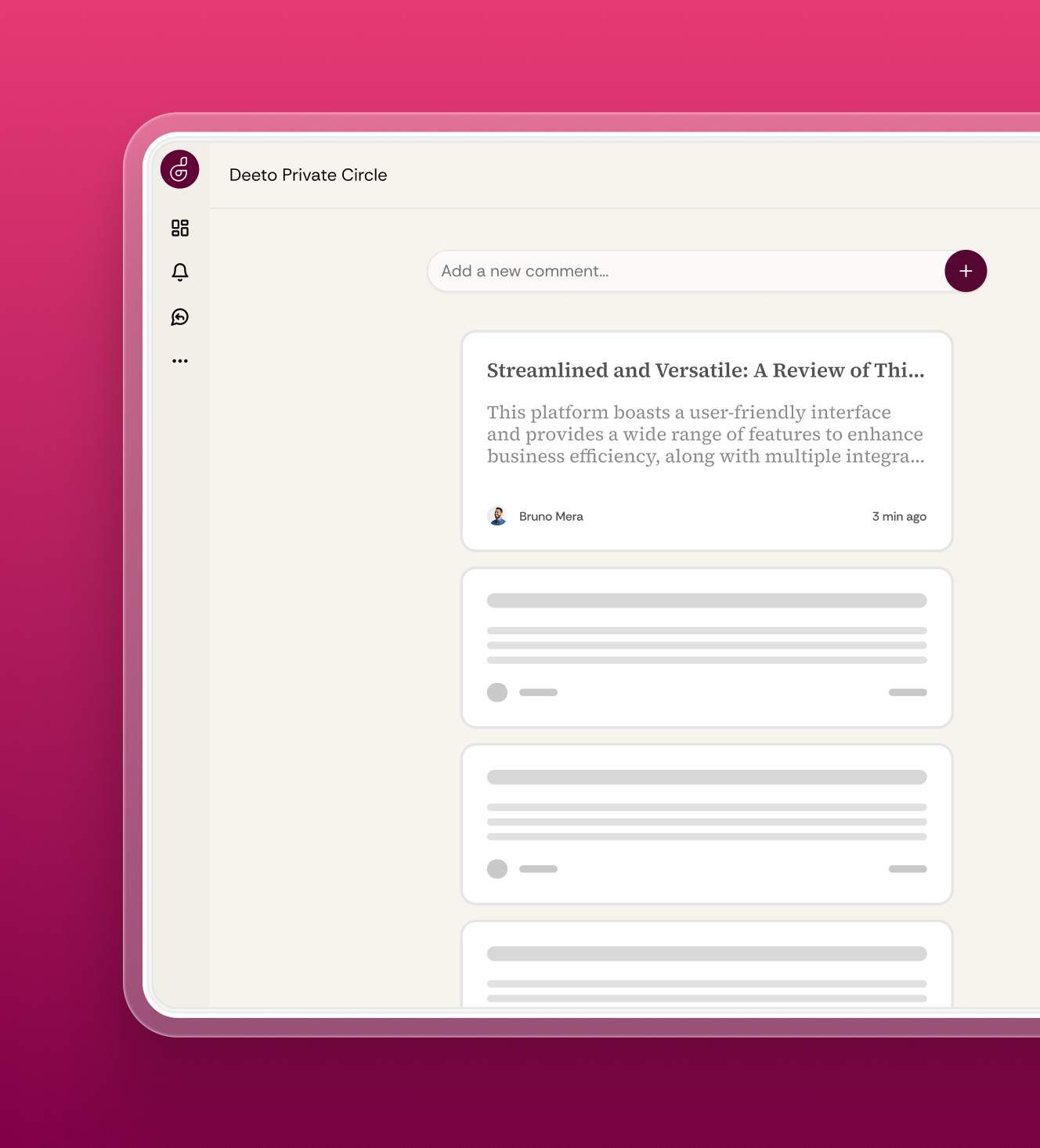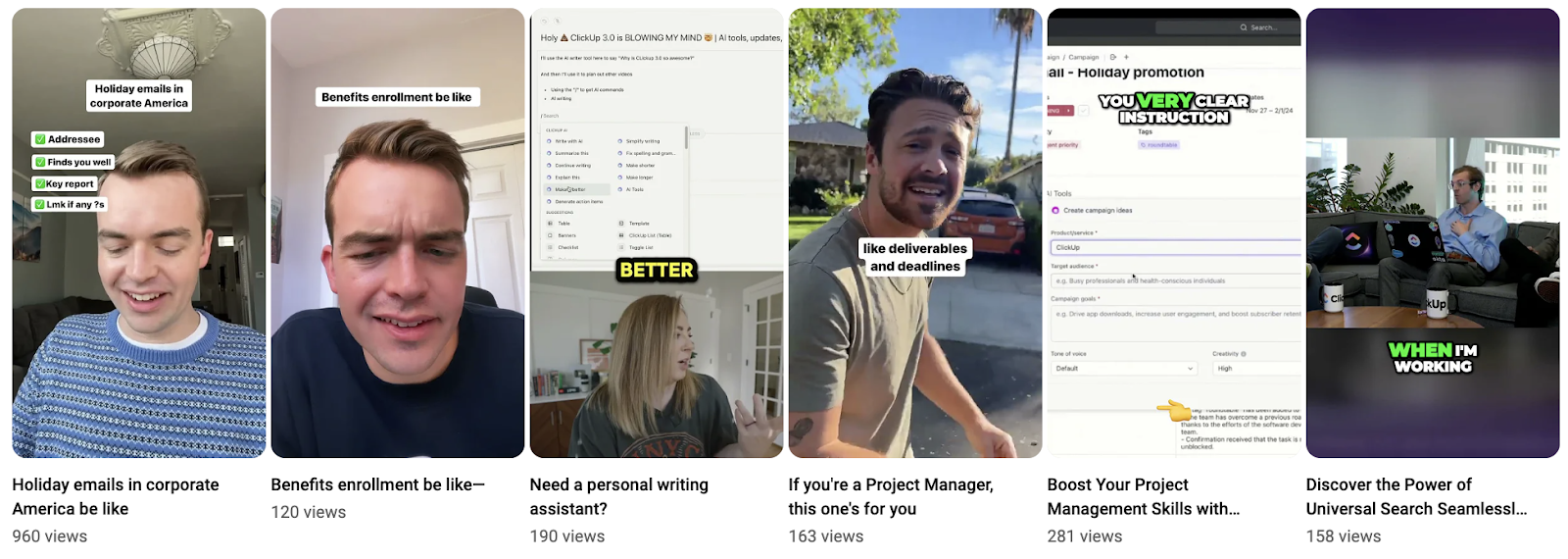
Welcome to the Deeto Hub
A resource and community space for modern marketers, sellers, and builders using customer voice to grow — together.

A resource and community space for modern marketers, sellers, and builders using customer voice to grow — together.
This hub is built for anyone who wants to do more with the voices of their customers. Whether you're scaling advocacy, building trust with proof, or rethinking how to go to market — you're in the right place.
How-to guides and playbooks for building with customer voice
Campaign-ready templates and swipe files
Benchmark reports and reference best practices
Event recordings, expert sessions, and community spotlights
Ask questions. Share ideas. Trade wins. This is your space.
You don’t have to figure this out alone. The Deeto community connects you with other leaders using customer voice to build better GTM motions, faster-growing brands, and smarter strategies. If you are interested in joining when it launches, sign up below.
Automate advocacy management workflows
Dynamically generate customer stories and social proof
Eliminate manual reference management
Track and report advocacy impact on revenue

Discover practical guides, templates, and tools to help your team close more deals, faster.
You probably measure customer activation in terms of how many people successfully complete the onboarding process or reach a certain level of engagement.
We aren't saying you shouldn't know your time to value or adoption rates. But truth is, that's a tiny step in the grand scheme of things.
Long term, you need customers who propel your business forward. People who...
In actuality, "activating" your customers is more about engaging them over time and solidifying a relationship. Jumping through hoops during onboarding is definitely the first step, but it's more about creating an experience that encourages long-term loyalty.
Let's dive into what it takes to accomplish that.
You can't even think about advocacy or expansion if you can't retain your customer base. And retention starts with onboarding.
The level of involvement you'll need in customer onboarding largely depends on the market you're selling into. Enterprise customers will, of course, need a lot more handholding than SMBs that deploy your solution only across a small team.
The basics:
86% of customers say they're more likely to stay loyal to a business that offers educational onboarding content. And before you engage customers in other facets of your business, like advocacy and testing, you have to get them excited about and continuously using your product.
Most companies get it wrong when it comes to choosing customers for customer activation programs. They pick a small group with whom they already have personal relationships or who show the highest CLV or engagement levels.
If you do this, you're leaving out tons of customers who would otherwise participate and grow their relationships with your brand.
Very few (if any) will participate in all of these activities. And some of your best participants won't be who you expect. That's why you need to invite everyone to join you and let each of them choose how they contribute.
If you're having trouble getting customers to participate at scale, 99% chance "you're making it too hard" is the reason.
If you want to turn customers into brand advocates, your program needs three things:
This sounds intimidating, but it's actually pretty easy to set up. With Deeto, customers onboard themselves and choose their contribution preferences. From there, they’re able to create a variety of content — quotes, reviews, testimonials, and even case studies — with the help of AI. And they can track their contributions’ impact and receive corresponding rewards, all in one place.
Sure, they'll be happy to write reviews, provide reference calls, and test new products. But you can't always ask for favors.
While advocacy and providing hands-on feedback are the best ways to create a highly engaged customer base, you also have to communicate with them in ways that add value to them.
You should also involve them in some of your marketing campaigns through user-generated content. When customers talk about or showcase their experience with your product, using it in your social media and web content will reinforce their relationship with your brand.
Practically every lead in your pipeline will want to see some form of social proof before signing the dotted line. Your customers can help you here in real time through reference calls, but your reps can also use content like case studies, reviews, and user-generated videos in their sales conversations. With smart matching, they’ll see
Your customers can help you here in real time through reference calls, but your reps can also use case studies, reviews, and user-generated videos in their sales conversations. With Deeto's smart matching feature, they’ll automatically see the most relevant content based on a lead's profile, interests, and stage in the buyer's journey.
You can run your whole customer activation program with Deeto. Request a demo to see how.

Learn how to build a client activation program that turns happy customers into powerful growth drivers.
In 2024, social proof is the most valuable marketing currency.
The overwhelming majority of today's buyers look for reviews, testimonials, case studies, and other forms of customer-generated content before they even consider a purchase. Or, they consider a vendor their friend referred them to.
Why? Authenticity.
When someone vouches for your brand, they're doing it by choice. And that does heaps more for your credibility than any ad campaign.
So...how do you get more of your customers to be advocates? How can you turn as many positive experiences into recommendations and referrals as possible?
You have to build a customer advocacy program.
There are plenty of reasons for this, but they all boil down to a few common denominators.
The bottom line: you're limiting your own potential by making it too hard both for you and for your customers.
Despite the challenges of building a successful customer advocacy program, it's absolutely worth it. Social proof can increase web conversions by 270% and nearly 9 in 10 B2B decision-makers say they use it before investing in new products.
Plus...
A win-win. But you have to do it right.
The modern customer demands a frictionless experience and remarkable personalization. When it comes to your advocacy process, they expect the same — streamlined, engaging, and satisfying.
Here's what you need:
Sure, you want more sales. But true advocacy starts with thoughtful communication. You should strive to create an engaged community that advocates for your brand not because they have something to gain, but because they truly believe in you.
We mentioned the nightmare of managing everything manually via spreadsheet and email. It's also worth mentioning software won't help you much either if your processes operate in silos.
...should all happen under one roof. And needs to be self-service, so there's no need for extensive back-and-forth dialogue with your customers.
Artificial intelligence and process automation are the game-changers in customer advocacy today.
Use a platform like Deeto to:
With the right tools in your corner, it's a whole lot easier to personalize at scale and make your program a joy to participate in.
But remember, the whole point of advocacy is building relationships. Although it's a software-enabled process, you still need to make it authentic and human.
That means:
Deeto makes it easy to do all these things and more. If you want to learn how to build a frictionless, authentic customer advocacy program that amplifies your brand and helps you build stronger relationships with your customers, request a demo today.

In 2024, social proof is the most valuable marketing currency.
Perhaps it goes without saying: the success of your customer activation program hinges on the types of customers who participate (and the quality of their feedback).
You want advocates who are:
But you also need their content to be authentic, relevant, and valuable for potential customers.
And that's where things get a little more challenging.
Since there's so much pressure around the questions of "Who would best represent our brand?" and "How can we get them to produce content?" most companies prioritize the recruitment of advocates over creating opportunities for them to contribute.
Sure, this approach nets you a handful of advocates. But it neglects the larger purpose of a customer activation program: to build trust and credibility in your brand through authentic voices.
Filtering out initial invites lowers your chances of building strong relationships with your customer base. And it's based on pre-made assumptions.
Instead of spending so much time in the beginning picking the "right" customers, open your advocacy program to everyone in your customer base.
This means providing all of them with the opportunity to contribute, in a streamlined process that doesn't require too much time and effort.
This way, they can create content (think: reviews, testimonials, and even case studies) unique to their own experiences. Then, you can decide which of that content is relevant to different sales and marketing initiatives.
With this approach, you're avoiding the time-consuming process of hand-picking advocates. You're also establishing a more authentic and diverse representation of your customer base. And you're encouraging more customers to spread positive word-of-mouth about your brand.
Plus, the feedback you'll get from casting a wider net of customers will give you insights into their pain points and preferences. This can help you improve your products and services and, in turn, attract/retain more customers.
"Don't jump the gun by filtering out customers in the beginning."
That's a bit vague. How can you tell which advocates and content are the "best" for your brand?
Let's dive in.
The only way you'll be able to gather the content you need is through a streamlined, automated system.
With a platform like Deeto, you can:
For your customers, the workflow is intuitive and fast. For you, the data is easy to access, and the content is optimized for your sales and marketing initiatives.
There are several different types of social proof. Some customers will be more comfortable with certain types of content over others. For example, some may prefer to write a review while others may want to participate in an interview.
Make sure you have options for customers to choose from, such as:
By tailoring your advocacy program to the individual customer, you're opening up the possibility for all types of social proof to emerge.
Now that you have a variety of content at your disposal, the question remains: What can you do with it?
Really, the use cases are endless.
You can also use customer feedback to inform future marketing and product development initiatives. Let's say you get quite a few comments about a feature customers wish you offered. You can use that feedback as a starting point for product development, then update your advocates and the rest of your customer base once you implement it.
Since it translates so well to web and social content, companies tend to see customer activation content as a marketing-only tool.
Really, there are several ways it drives B2B sales.
When you integrate Deeto with your CRM, you can use its smart-matching capabilities to connect specific content to individual prospects in your pipeline.
That way, you can personalize your outreach and give potential customers content that actually matters to their use case. And you can find the perfect customer reference for every prospect without having to do any manual digging.
Cherry-picking a few advocates for your program sounds like a good approach. It's only natural to think that the more "ideal" customers you feature, the better your brand will look.
In reality, that's not the most efficient or effective way to build brand trust and drive sales. By opening up your program to all of your customers and using customer activation software, you can create a more diverse representation of your customer base.
Request a demo with Deeto to see how your customers’ voices fit into your overall marketing and sales strategy.

Master customer activation by choosing the right advocates to boost engagement, trust, and conversions.
Without enough UGC, you'll never have an active, engaged community. And you won't have coverage for all the topics, features, and use cases that matter to your prospects.
If the content you do have isn't good, though, the amount of it won't make a difference.
In truth, you need both. A solid UGC strategy balances high-quality content with a steady stream of contributions.
In today's article, I'll walk you through how to strike that balance.
User-generated content (UGC) is any type of content created by your customers for your brand. In the B2B space, it includes:
Anything a customer creates and shares that references your brand counts as user-generated content.
UGC is social proof. You'll use it in your web content, email campaigns, and social media collateral to show prospects the value your product or service delivers. You can even integrate it into your sales cycle by sharing reviews and testimonials with leads to help them make a buying decision.
In a B2B context, high-quality customer-generated content meets three criteria:
As an example, if you're trying to win over healthcare companies, reviews from retail businesses won't carry much weight. And if your sales rep wants to win over a technical buyer, a case study about your product's ROI (that says nothing about integration or security) won't be a good fit.
The content you do share with customers doesn't have to be polished marketing copy. But it should be coherent and easy to understand.
And it should explicitly showcase the value of your offering through feature mentions, statistics, and tangible benefits (e.g., "Since using Product X, we've seen a 25% increase in production efficiency").
92% of B2B buyers say they're more likely to make a purchase decision after reading a trusted review. But G2 found that almost two-thirds of them want to see 11-50 reviews before they feel confident.
This is just one simple example of how higher volumes of user-generated content do a better job of nurturing leads through the sales funnel.
But reviews are just one type of UGC. For every deal, you're working with...
You need different types of UGC to support these touchpoints (and personalize them).
One case study won't relate to 10 different prospects. So, without enough content, you simply won't have adequate coverage.
It's also worth mentioning that the bigger your existing UGC repository, the more confident new customers will be about adding to it. When they see lots of other people contributing, it'll feel more like a community than a one-off gesture.
As is true with any kind of marketing, thinking only in terms of "quantity" is quite limiting. Instead of asking yourself, "Are we garnering enough user-generated content?" ask, "What are we getting out of the content we are creating?"
Think about:
Then, get creative. You can maximize the amount and quality of UGC you have by:
While you need quality, you can't afford to move slowly. Good news is, you don't have to — spending weeks on finding the “right” customer, interviewing, hiring copywriters and editors, etc., is a waste of time.
A platform like Deeto makes sourcing and managing UGC easy and cost-effective. Customers onboard themselves, choose their contribution preferences, and create content in minutes. Deeto's generative AI turns their feedback into usable case studies and dynamic web content. And smart-matching functionality connects your reps with relevant content for each sales conversation.
Request a demo to see how it can activate your customers, increase UGC volume and quality, and help you win more business.

Boost B2B trust & conversions: Balance UGC quality & quantity. Strategies for authentic content. Learn more.
Word-of-mouth: your most powerful (and important) marketing asset. Also, the most difficult one to manage cohesively.
Customer advocacy platforms are designed to help you encourage and manage customer reviews, referrals, testimonials and other forms of user-generated content at scale. If you have a good one, it can bring the power of social proof to you in ways you never thought possible.
But with several options each with somewhat different feature sets, how do you choose the right tool for your business?
Three reasons stick out as to why Deeto is the obvious choice here.
There are plenty of reasons companies struggle to turn their customers into brand advocates. Maybe your advocacy program...
All these potential pitfalls have one thing in common: they're direct results of putting the advocate last.
Most programs focus on (a) customers' contributions and (b) how they can help promote the brand. Little thought goes into what participants get out of the exchange or how easy it is to advocate.
You aren't to blame, though. If you're still handling communication through email and spreadsheets, it's impossible to keep the customer as your primary focus.
We designed Deeto to help you take the exact opposite approach.
Deeto's platform is both business- and customer-facing, meaning customers can onboard themselves. They define their own contribution preferences, input feedback, and Deeto's automated scheduling, smart-matching, and content generation capabilities take care of the rest. As they make contributions, they can track their impact and earn rewards.
It's an all-around more engaging experience. And it's one with far less friction.
From personalizing your own onboarding to imprinting your brand on user-generated content, Deeto gives you the ability to make your advocacy program truly yours.
Deeto's intelligent matching capabilities can also personalize which advocates are connected with which prospects. Your sales team can quickly get the right references in front of their prospects, increasing your chances of closing that sale.
At the same time, the platform's dynamic web content personalization feature helps you accelerate your sales cycle. It allows you to showcase the most relevant customer reviews and testimonials based on a visitor's interests, use cases, and behavior.
Aside from being a clear win for you, that level of personalization maximizes the impact of your customers' advocacy contributions. When advocates see their input actually drives business results, it reinforces their value and encourages them to stay active.
There are lots of ways your customers can advocate for you — referrals, reviews, written/video testimonials, case studies, reference calls, and more.
There are also countless ways your sales and marketing teams can use these contributions. And at different points in the sales cycle, buyers' priorities shift, calling for different types of social proof.
Before Deeto, you probably had to use different tools for each one. With Deeto:
And the icing on the cake: Intelligent suggestions help your sales team use customer-generated content in sales conversations in the most effective, targeted ways possible.
Request a demo to see how it works.

Word-of-mouth: your most powerful (and important) marketing asset. Also, the most difficult one to manage cohesively.
In B2B customers are always going for (a) the best solution for their company and (b) the best all-around experience.
Why? Because they know they’re required to have a long-term relationship with your company.
If you can’t deliver the engagement they’re looking for, they’ll leave as soon as they get the chance.
On a macro level, it's how you quantify the connection between your customers and your brand. But most companies overlook an important in-between step: customer engagement isn't just about the connection, it's about all the different processes that lead to that connection.
How you create, build, nurture, and maintain relationships with your customers all fall under the umbrella of customer engagement.
In a nutshell, that's what you should actually think of when someone in your organization brings up "customer engagement."
Anticipating your customers’ needs before they have to voice them is a great way to show them you've got their back.
Your customers themselves are the best sources of data, here. To know what they're going through, you need to focus your customer engagement strategy on continuous bi-directional communication and feedback.
There's no shortage of ways to do this, but here are a few battle-tested ideas to consider:
Either directly or through data analysis, these channels translate to insights you can use to make proactive improvements to the customer experience. When are they usually available? Which features would they like you to implement? What information are they looking for but can't find?
Countless businesses have a tendency to close the deal and forget about it. They might have a newsletter, a blog, and surveys they send out periodically. These are great for keeping clients updated, but they don't facilitate regular contact that pertains to how they use your product.
You need to maintain a consistent presence in your customers' minds. And that's where regular touchpoints come in.
The key here is to find the right balance between being helpful and being intrusive. You want to be present and valuable, but not overbearing.
"Add value" is B2B Sales 101.
Every high-performing seller knows not to ask for a demo right away. They have to give first, whether it's through time or information.
This concept is also something you need to apply to your customer engagement strategy.
When customers see genuine effort to provide value outside of the transactional relationship, they're more likely to reciprocate by staying engaged with your brand (and recommending it to others).
Every business needs expert ambassadors — customers so engaged with your company they'll want to share their experiences with others.
A customer advocacy program is all about turning someone who bought or subscribes to your product into an active promoter who:
Once you've emotionally connected with your customer base on that level, you've cracked the code. They'll always want to talk about you because they feel proud, taken care of, and part of your tribe. And you'll have the social proof to show for it.
Use Deeto to run your entire customer advocacy program. Customers input their own feedback, availability, and communication preferences. Whenever they refer a customer, participate in a reference call, leave a glowing review, or help you create quality content, they can get rewarded for their word-of-mouth contributions. Request a demo to see how it works.

Learn how to increase customer engagement with 4 actionable tips that boost loyalty and long-term value.
What drives your sales? You might be tempted to say "our marketing," "our tech stack," or "our all-star sales team."
And you'd be 100% right. But you're missing one crucial element: your customers.
91% of B2B buyers say they rely on word-of-mouth when making purchase decisions (though, really, I doubt the other 9% are out here making major investments in enterprise software without at least checking a few reviews).
No matter what, hearing how great your product is from someone your prospect can relate to will always have more of an impact than telling them yourself through ads, cold email, and a product demo.
Advocacy can become a powerful force in your sales strategy when harnessed correctly, especially as part of a program to accelerate sales.
In this day and age, whether or not you convert a healthy number of customers is directly tied to your ability to leverage your current customer base at every stage of the sales process.
The biggest problem companies run into when scaling their customer advocacy program is taking a one-size-fits-all approach.
The truth is, like every prospect in your pipeline, every advocate is different, and a successful customer marketing strategy plays to each of their strengths.
All these, plus a particular advocate's communication/contribution preferences and their role/level of seniority within their company, change how they can support your sales process.
To use your customers to their fullest extent, you have to think, "How can I use my customers' experiences to connect with my prospects in a way they'll trust and relate to?"
Then, you have to gather the right mix of content to address your customers at every stage of the sales cycle.
G2's 2023 Software Buyer Behavior Report found that ~84% of today's decision-makers use third-party review sites as part of their buying journey. And, according to research from Gartner, they collectively hold roughly 1.4x the weight of anything you'd publish yourself.
They're authentic, transparent, and segmented based on what the buyer cares about as opposed to what you want them to see.
The good news: This is something you can do right now.
Start with highly engaged customers who have been with you awhile and have a lot of good things to say. Identify them based on product use, payment/order history, and NPS/customer satisfaction scores.
Send them an automated email inviting them to leave a review on G2, Capterra, or TrustRadius (you can set this up by making a free account). Include a small incentive, like a $20 gift card.
Deeto’s new G2 integration makes this even more frictionless for your customers. You can invite them to leave a review within the platform. They don’t have to switch screens or spend 15 minutes setting it up.
Your buyers are 57% to 70% through the decision-making process by the time they talk to your sales team, and most of their research is done online. So, the impact of this contribution spans several stages of the sales funnel — from Awareness to the final decision.
Since most of the sales process happens without intervention from sales, you need adequate web content to guide decision-making.
Incorporating ratings, testimonials, quotes, and stats into your landing pages, product/service pages, and articles will definitely boost your web conversions. But personalized UGC takes it a step further.
Use a tool like Deeto to efficiently create customer content, then display your reviews, user stories, and video testimonials live on mobile and desktop.

Depending on who is visiting the page, which page they visit, and their previous site behavior, they'll see content that's most relevant to them.
If your sales team has problems with low open and click-through rates, it's probably because they're sending generic emails and InMails.
Sending out messages by the 1,000s might have worked in the '90s. These days, being in a decision-making capacity means your inbox is flooded with stuff like this:

No, the email didn't find me well. delete
Deeto's smart-matching algorithm shows your sales team which of your current customers have similar use cases and jobs, plus all the content they've left in the system.
From there, reps can personalize their conversations at every stage of the funnel — Awareness-stage prospects, lead nurturing for mid-stage buyers, and consultative sales late in the game.
Once you deliver a personalized sales demo, your prospect's buying group will have plenty more questions.
Allowing later-stage prospects to chat live with current customers will give them the real story. It answers their questions in a way your sales team can't.
The same smart-matching algos used to personalize sales outreach also connect prospects and references, so your sales reps don't have to play Matchmaker when setting these conversations up.
If you think the sales cycle ends when someone signs the dotted line, you're wrong. Especially if you use a recurring revenue model (SaaS, I"m talking to you), customer engagement is the name of the game.
Your advocacy program is the perfect way to (a) keep happy customers engaged with your product and (b) turn your customer base into a lead generation tool.
Over the long term, that's what really increases sales velocity and CLV.
If you're reading this and thinking, "I can't manage this all in a spreadsheet," you'd be 100% right. Software really is the enabler, here. Run your whole customer advocacy program with Deeto.

Accelerate the sales cycle using your current customers with these 5 proven, efficient strategies.
When asking yourself, "How can we improve our sales and marketing results?" you might look within. Really, it's about the customer.
86% of B2B buyers say what your current customers think of you is the most influential factor in their purchase decision.
The question is: How do you capture your customers' experiences and put them where your prospects are doing their research?
Easy. A customer advocacy strategy.
Customer advocacy is a sales and marketing strategy that focuses on leveraging the positive experiences and opinions of current customers to attract new ones.
It comes in many forms:
Basically, it's word-of-mouth marketing but amplified through technology and intentional, strategic efforts.
I've already written extensively about launching a customer advocacy program. If you're new to this, start there.
Your product has dozens of features, use cases, and benefits. And you presumably have multiple ICPs.
If all you're doing is broadcasting your customers' successes without consideration for who actually relates to them, you'll be hard-pressed to convert leads to customers.
So, figuring out which customers are the best fit for certain types of outreach and targeted messaging is an important first step.
Consider:
The same way you'd build a buyer persona to represent an ICP, create profiles for your advocates. That way, you can take a targeted approach that plays to their strengths, individually.
Plus, this ensures the messages you're amplifying through customer advocacy align with the messages the prospect in question actually cares about.
I can't stress this enough. Make helping you as frictionless as possible.
There are several reasons you might have trouble scaling your customer advocacy program. The vast majority boil down to a lack of resources and structure for those involved.
With a platform like Deeto, you can:
Plus, generative AI takes your customers' inputs and spins them into compelling case studies with minimal work for your team.
Today, practically everyone knows why you need social proof. But most customer marketing programs stop at placing reviews and testimonials on targeted pages (or asking for them on third-party sites).
What most companies seem to miss is the fact you can use your current customer base throughout the sales cycle.
Personalization is the key, here.
Different members of a buying group have different concerns. And they'll want to see different types of social proof, depending on where they are in the decision-making process.
Deeto's smart matching function makes this easy. Using their profiles, it automatically matches up prospects with best-fit customers and content for their use case, industry, and role.
You probably don't realize the extent to which you can actually weave customer advocacy into your other marketing initiatives. The possibilities are endless.
Of course, you want to add social proof to your email/ad campaigns, landing pages, product/service pages, and blog posts. But today's companies can take it a step further with personalized UGC.
Use customer marketing software that displays dynamic content based on who's visiting the page, which page they're on, and their history. That way, each person sees content that's most relevant to them.
You have to make your program compelling enough for advocates to keep sharing content and leads.
If you're accurately pairing advocates with prospects, you're halfway there (why would they waste their time on a low-impact program?).
But you can build on that.
In addition to increasing engagement within the program, this is what drives long-term retention and, by extension, healthier cash flow. And that's how it all comes full circle.
You can't do it all on your own, though. Well...you can. You just need software. ;)

When asking yourself, "How can we improve our sales and marketing results?"
You know the saying, "Easy come, easy go"? That's paid ads in a nutshell.
Let's preface this by saying there are clear use cases for PPC, PR, and other paid programs. And, of course, organic marketing isn't "free" — it'll still cost you time and resources.
But for the long-term growth and success of your business, organic marketing should be your primary focus.
Organic marketing is the art of driving traffic, leads, and sales without paying for ads. It's a long-term marketing strategy that focuses on building strong relationships with your current and potential customers through valuable, relevant content and customer engagement tactics.
Examples of organic marketing include:
Although organic marketing comes in all different flavors, the core theme is the same: you're investing time and effort into building relationships with your audience, rather than just throwing money to attract them.
Across the board, your cost per lead (CPL) is as much as half when you use organic marketing compared to paid campaigns.

In B2B SaaS, for example, the average paid lead costs $310.
The average organic lead? $165.
By extension, your CAC is also significantly lower. But there are other factors that contribute to a lower CAC throughout the sales cycle:
So, the residual impacts of your organic marketing efforts are a shorter sales cycle and a higher conversion rate — both of which reduce the overall cost of acquiring a customer.
The main benefit to organic marketing is that it's a long-term strategy.
Yes, you won't see immediate results like you would with paid ads. But organically generated traffic and leads are more reliable and sustainable over time.
Once you've established a solid organic marketing foundation, your efforts will continue to drive results without the need for constant investment.
B2B and B2C buyers alike use the internet to research and make purchase decisions. And they're becoming increasingly savvy at ignoring or blocking out paid ads.
In fact, just 8% of buyers see an ad and automatically think its claims are true.
Compared to the information they find organically on Google or through other people, those ads don't stand a chance when it comes to making an actual buying decision.
When you see an ad like this…

…it might grab your attention. But it sounds over the top.
But when you find reviews on their website or organic search?

You tell us what’s more believable.
People like to buy from companies they like and trust.
That's why 89% of people end up buying from a company they follow on social media. And it's why 92% of buyers are hesitant to try a product with no reviews or testimonials.
Organic marketing allows you to showcase your brand's personality, build trust with your audience, and form a community around your product.
For example, by integrating UGC into your sales cycle, you're doing more than just making your brand more trustworthy.

Customers who see their content repurposed on your feed will automatically feel more connected to your brand. And others who see it will know right away that you're the type of company that values its customers.
Plus, they'll get to see how others use your product.
Arguably the most valuable benefit of organic marketing is the fact that, once you've built a strong foundation, it continues to work for you even when you're not actively putting in effort.
The social media following, search engine presence, and customer relationships you build stick with you forever.
Of course, it isn’t set-it-and-forget-it. Assuming you pursue organic marketing with consistency, you'll rely on paid media less and less as time goes on. When you launch new products and features, you can bring them to market right away.
And your reputation becomes your best salesperson.

You know the saying, "Easy come, easy go"? That's paid ads in a nutshell.

See how Deeto helps you turn customer voice into a GTM advantage.
© 2025 Deeto. All rights reserved.